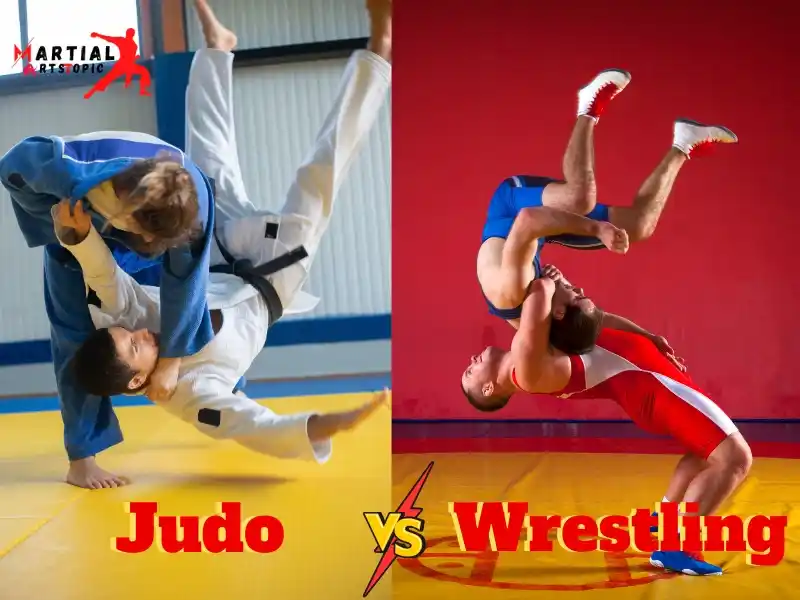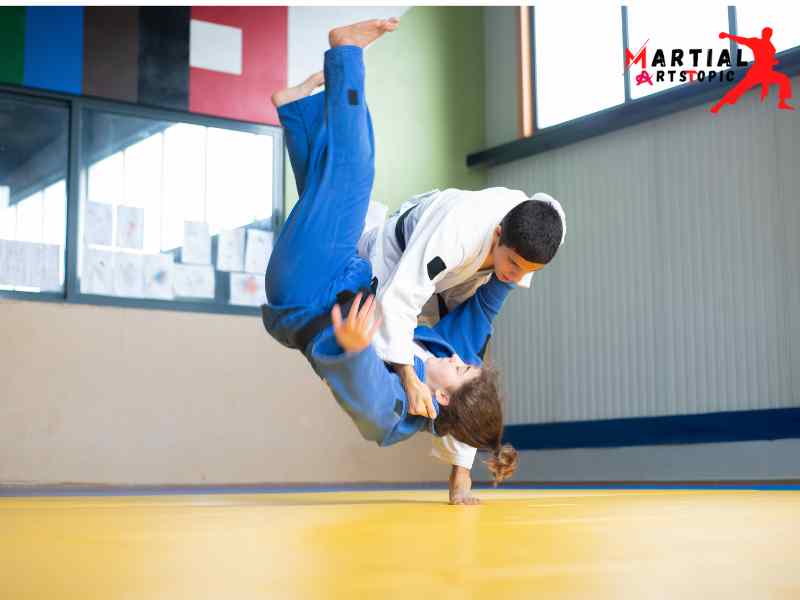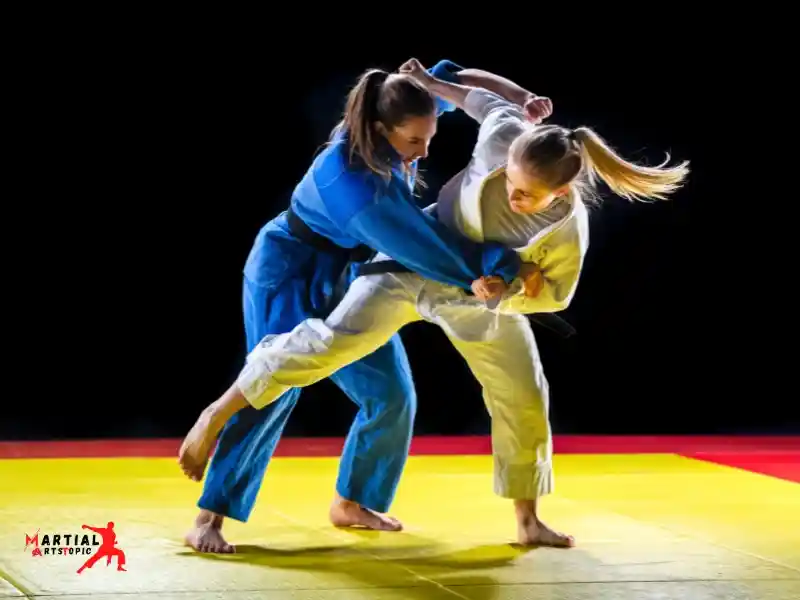
Judo vs Wrestling: The Differences and Similarities
Judo and wrestling are both powerful martial arts with unique techniques and strategies. While they share some similarities, they also have distinct differences that set them apart.
- Grappling: Both judo and wrestling emphasize grappling techniques, focusing on controlling and manipulating an opponent through clinching, takedowns, and ground control.
- Strength and Conditioning: Both disciplines require high levels of strength, agility, and endurance. Athletes in both judo and wrestling undergo rigorous training to develop these physical attributes.
- Focus on Technique: Both judo and wrestling place a strong emphasis on technique and leverage. Practitioners must master a variety of throws, holds, and pins to effectively compete in their respective sports.
Differences
- Rules and Scoring: Judo matches are scored based on throws, takedowns, and ground control, while wrestling matches focus on takedowns, escapes, and exposure of an opponent’s back.
- Uniform and Grip: Judo practitioners wear a gi (uniform) and often use it to perform throws and holds, while wrestlers wear tight-fitting singlets and focus on body-to-body contact.
- Striking Techniques: Judo does not allow striking or kicking, while some forms of wrestling, such as freestyle and folk style, allow limited use of the legs for offensive and defensive maneuvers.
It’s important to note that both judo and wrestling have their own unique philosophies and training methodologies. Judo emphasizes the concept of “maximum efficiency, minimum effort,” while wrestling focuses on controlling an opponent through superior positioning and leverage.
Origins and History

Judo and wrestling both have rich histories that have shaped their development into the popular martial arts they are today. Judo, originating in Japan, has its roots in the ancient samurai fighting techniques and was later formalized into a sport in the late 19th century. On the other hand, wrestling has a long history dating back to ancient civilizations such as Mesopotamia and Egypt, with various forms emerging across different cultures. Both Judo and wrestling have developed through centuries, with judo emphasizing throws and grappling, while wrestling focuses on takedowns and ground control. Understanding the origins and historical contexts of these martial arts can provide valuable insights into their techniques and philosophies.
Origins of Judo
Judo, which translates to “gentle way,” originated in Japan in the late 19th century. Its development can be attributed to Jigoro Kano, a visionary martial artist who sought to create a system of self-defense that emphasized technique and leverage over sheer strength. Drawing inspiration from traditional Japanese martial arts such as jujutsu, Kano meticulously crafted Judo, infusing it with a profound philosophy that extended beyond the realm of combat.
Historical Evolution
As Judo gained momentum, it underwent a remarkable evolution, transcending cultural boundaries to attain global recognition. With its emphasis on discipline, respect, and mutual benefit, Judo transcended its role as a mere fighting style, developing into a way of life for countless practitioners worldwide. Its inclusion in the Olympic Games further solidified its status as a revered martial art, captivating audiences with its grace and power.
Modern-Day Significance
In the present day, Judo stands as a testament to the enduring legacy of its founder, Jigoro Kano. Its universal appeal and enduring relevance make it a cornerstone of martial arts, attracting enthusiasts of all ages and backgrounds. The principles of Judo, encompassing both physical and mental fortitude, continue to inspire individuals to strive for excellence and harmony in all aspects of life.
Wrestling the Ancient Origins
Wrestling can trace its roots back to ancient civilizations such as Mesopotamia, Egypt, and Greece. In ancient Greece, wrestling was a revered sport and was featured in the original Olympic Games as early as 708 BC. The Greeks saw wrestling as a display of strength, skill, and honor, and it became an integral part of their cultural identity.
Evolution in Different Cultures
As civilizations spread and interacted, wrestling took on various forms and styles. In Japan, sumo wrestling emerged as a symbolic ritual with deep religious and cultural significance. In India, the ancient martial art of kushti wrestling became a celebrated tradition, emphasizing discipline and spiritual growth alongside physical prowess.
Colonial Influence
During the colonial era, wrestling found its way into the hearts of people in the Americas, where it became a popular form of entertainment. Catch wrestling, a style that originated in England, gained prominence in the United States and laid the foundation for modern professional wrestling.
Modern-Day Wrestling
Today, wrestling continues to thrive as a global phenomenon, with various styles and disciplines captivating audiences worldwide. Greco-Roman wrestling, freestyle wrestling, and professional wrestling have all carved out their own unique niches in the sports and entertainment industries.
Influence on Popular Culture
Beyond the realm of sports, wrestling has left an indelible mark on popular culture. Iconic wrestlers such as Hulk Hogan, The Rock, and Ronda Rousey have attained superstar status, transcending the boundaries of the wrestling ring and becoming household names.
The Future of Wrestling
As we look to the future, it’s clear that wrestling will remain a powerful force, blending tradition with innovation. With the rise of mixed martial arts (MMA) and the continued evolution of professional wrestling, the sport is poised to reach new heights of mainstream appeal and global recognition.
Techniques and Principles

When comparing Judo and Wrestling, it’s important to understand the fundamental techniques and principles that differentiate the two martial arts. Judo, with its emphasis on throwing, pinning, and submission techniques, focuses on using an opponent’s energy against them. On the other hand, Wrestling places a heavier emphasis on takedowns, controlling positions, and ground fighting. Both disciplines require strength, agility, and strategic thinking, but their technical approaches and competitive rules set them apart. Understanding the nuances of each art can provide valuable insights for practitioners and enthusiasts alike.
Core Principles of Judo
At the heart of Judo are several core principles that guide its practice:
- Seiryoku Zenyo (Maximum Efficiency): This principle emphasizes the efficient use of mental and physical energy. In Judo, practitioners learn to leverage an opponent’s force and momentum to gain the upper hand, rather than attempting to overpower them through sheer strength.
- Jita Kyoei (Mutual Welfare and Benefit): Judo places a strong emphasis on mutual respect and cooperation. Practitioners are encouraged to strive for harmony and mutual benefit, both on and off the mat.
- Ju No Ri (Principle of Gentleness): This principle underscores the idea of yielding to an opponent’s force and redirecting it, rather than meeting force with force. By embracing flexibility and adaptability, practitioners can overcome stronger opponents through skillful technique.
Fundamental Techniques of Judo
Judo encompasses an array of techniques, including throws, joint locks, and grappling maneuvers. Some fundamental techniques include:
- Osoto Gari (Major Outer Reap): A powerful throwing technique where the practitioner sweeps their opponent’s leg, destabilizing them and causing them to fall.
- Osaekomi Waza (Hold-down Techniques): These techniques are used to immobilize an opponent on the ground, gaining control and potentially leading to a submission.
- Juji Gatame (Cross Armlock): A joint-locking technique that targets the opponent’s elbow joint, applying pressure to force a submission.
- Ude Hishigi Juji Gatame (Armlock): This technique involves locking the opponent’s arm and applying pressure to force them into submission.
Wrestling Techniques
- Stance and Footwork: A solid stance and proper footwork are essential for any wrestler. Maintaining a low, balanced stance and moving quickly and efficiently on your feet can give you a significant advantage over your opponent.
- Takedowns: Takedowns are fundamental in wrestling and involve techniques such as single-leg takedowns, double-leg takedowns, and various throws. Mastering these techniques can help you control the match and score crucial points.
- Escapes and Reversals: Being able to escape from your opponent’s control and execute effective reversals can turn the tide of a match in your favor. Learning these techniques is essential for any wrestler.
- Pinning and Control: Pinning your opponent to the mat is the ultimate goal in wrestling. Understanding how to control your opponent and work towards a pin is crucial for success in this martial art.
Wrestling Principles
- Balance and Leverage: Wrestling is all about using your body’s balance and leverage to gain an advantage over your opponent. Understanding how to manipulate your opponent’s balance while maintaining your own is a key principle in wrestling.
- Timing and Precision: Timing is everything in wrestling. The ability to execute techniques with precision and perfect timing can make the difference between winning and losing a match.
- Mental Toughness: Wrestling requires a high level of mental toughness. Pushing through fatigue, staying focused, and maintaining a strong mindset are essential principles for success in this challenging sport.
- Adaptability: Wrestlers must be adaptable and able to adjust their techniques and strategies based on their opponent’s movements and actions. The ability to adapt quickly can give you a significant advantage in a match.
Training and Fitness

When comparing Judo vs Wrestling in terms of training and fitness, both disciplines offer unique physical benefits. Judo focuses on throws, takedowns, and ground grappling, requiring practitioners to develop strength, agility, and balance. On the other hand, Wrestling emphasizes takedowns, pinning, and ground control, demanding exceptional strength, endurance, and explosive power. Both Judo and Wrestling provide intense full-body workouts, enhancing cardiovascular endurance, muscle strength, and overall athleticism. Whether you prefer the artful throws of Judo or the raw power of Wrestling, both disciplines offer effective ways to improve fitness and build a powerful body.
Training and Fitness for Judo
- Set Clear Goals: Before you begin your judo training, it’s essential to establish clear and achievable goals. Whether you aim to improve your technique, increase your strength, or enhance your flexibility, having specific goals in mind will help guide your training regimen.
- Focus on Technique: Judo is a sport that heavily relies on technique and precision. Spend dedicated time honing your fundamental judo movements, such as throws, pins, and groundwork. Mastering these techniques will lay a solid foundation for your overall performance.
- Strength and Conditioning: Incorporating strength and conditioning exercises into your training routine is crucial for improving your judo skills. Emphasize exercises that target the muscles used in judo, such as core, leg, and upper body strength exercises. Additionally, cardio workouts can enhance your overall endurance, an essential component of judo competitions.
- Flexibility Training: Flexibility plays a significant role in judo, allowing for fluid and efficient movements on the mat. Implement regular stretching routines to improve your flexibility and prevent injuries. Yoga and mobility exercises can also contribute to increased flexibility and range of motion.
- Nutrition and Hydration: A well-balanced diet and proper hydration are integral parts of any athlete’s training regimen. Fuel your body with nutrient-dense foods that support energy levels and muscle recovery. Additionally, staying hydrated is crucial for maintaining peak physical performance during training and competitions.
- Rest and Recovery: While consistent training is essential, adequate rest and recovery are equally important. Over training can lead to burnout and increased risk of injury. Ensure that you schedule rest days into your training plan and prioritize quality sleep for optimal recovery.
- Mental Preparation: Judo is not only a physical sport but also a mental one. Practice visualization techniques to mentally prepare for competitions and challenging training sessions. Cultivate a positive mindset and focus on the process of improvement rather than solely on outcomes.
- Seek Guidance from Experts: Consider seeking guidance from experienced judo coaches and practitioners. Their insights and expertise can provide valuable training tips, corrections to your technique, and personalized advice to elevate your judo performance.
Training tips for Wrestling
- Master the Fundamentals: Wrestling, like any martial art, is built on a foundation of solid basics. Focus on perfecting your stance, footwork, and balance. These fundamentals form the backbone of your wrestling technique and are crucial for success on the mat.
- Strength and Conditioning: Wrestling requires tremendous strength, endurance, and agility. Incorporate strength training exercises such as squats, deadlifts, and pull-ups into your routine to build functional strength. Additionally, cardio workouts like running and interval training will improve your endurance for those grueling matches.
- Focus on Technique: While physical strength is important, technique is the true significant change in wrestling. Spend ample time drilling and refining your takedowns, escapes, and pinning combinations. Perfecting your technique will give you an edge over opponents who rely solely on strength.
- Mental Toughness: Wrestling is as much a mental battle as it is physical. Develop mental toughness by setting goals, visualizing success, and pushing through adversity. A sound mind can often be the deciding factor in a close match.
- Spar Regularly: There’s no substitute for live sparring. Regularly engage in controlled sparring sessions with training partners to put your skills to the test. This will help you adapt to different styles and improve your reaction time on the mat.
- Study Your Opponents: In the world of wrestling, knowledge is power. Take the time to study your potential opponents. Analyze their strengths, weaknesses, and tendencies. This insight will allow you to formulate a strategic game plan for your matches.
- Recovery and Rest: Rest is a critical component of any training regimen. Ensure you’re getting adequate sleep and allowing your body to recover between intense training sessions. Over training can lead to injuries and burnout, so listen to your body and prioritize rest.
- Seek Quality Coaching: A knowledgeable coach can provide invaluable guidance and feedback. Look for a reputable wrestling coach who can help refine your technique, offer strategic insight, and provide mentorship along your wrestling journey.
- Nutrition and Hydration: Proper nutrition and hydration are essential for peak performance. Fuel your body with a balanced diet rich in lean protein, complex carbohydrates, and healthy fats. Hydration is equally important, so be sure to drink plenty of water throughout the day.
- Consistency is Key: Lastly, consistency is crucial in wrestling. Make a commitment to regular training and stick to a structured routine. Wrestling is a demanding sport, and consistent practice is essential for improvement.
Benefits of Judo vs Wrestling

Judo and wrestling are two popular martial arts disciplines that have gained widespread recognition for their unique benefits. The distinct advantages of Judo and wrestling, shedding light on how each discipline contributes to physical fitness, mental fortitude, and overall well-being. Whether you’re a seasoned practitioner or a curious beginner, understanding the comparative benefits of Judo vs. Wrestling can help you make an informed decision about which martial art to pursue.Judo, a Japanese martial art, focuses on throwing, grappling, and ground fighting techniques. It emphasizes the concept of using an opponent’s energy and momentum against them, making it a highly effective form of self-defense. On the other hand, wrestling, with its roots in ancient combat sports, emphasizes takedowns, control, and pinning techniques. Both Judo and wrestling require strength, agility, and mental resilience, but they offer unique benefits that cater to different individuals.
Benefits of Judo
- Self-Defense Skills: Judo provides practitioners with the ability to defend themselves in real-life situations by utilizing an opponent’s force to gain control and neutralize threats.
- Total Body Workout: Judo techniques engage various muscle groups, promoting strength, flexibility, and cardiovascular endurance.
- Mental Discipline: Practicing Judo fosters mental focus, discipline, and the ability to remain calm under pressure.
- Sport and Competition: Judo offers opportunities for competitive sparring and tournaments, allowing practitioners to test their skills in a controlled environment.
- Self-Confidence: Mastering Judo techniques and achieving proficiency can significantly boost self-confidence and self-esteem.
Benefits of Wrestling
- Physical Strength and Power: Wrestling drills and exercises build functional strength, explosive power, and agility, contributing to overall athleticism.
- Takedown Mastery: Wrestlers develop exceptional takedown skills, which can be advantageous in both sports and self-defense scenarios.
- Resilience and Endurance: Wrestling training instills mental toughness, resilience, and the ability to push through physical challenges.
- Team Dynamics: Wrestling often involves team-based training and competition, fostering camaraderie, teamwork, and fair play.
- Rapid Decision Making: Wrestlers learn to think quickly and make split-second decisions, honing their cognitive abilities under pressure.
Judo vs Wrestling in Combat Sports
Judo and wrestling are two of the most recognizable and effective combat sports in the world. Both disciplines have a rich history and have been widely practiced for centuries.The key differences and similarities between Judo and Wrestling, exploring their techniques, strategies, and applications in combat sports. So, let’s step onto the mat and take a closer look at the fascinating world of Judo vs Wrestling.
Judo vs Wrestling: The Art of Takedowns
When we compare Judo and Wrestling, one of the most striking differences lies in their approach to takedowns. In Judo, the emphasis is on using an opponent’s energy and balance against them, often culminating in throws and takedowns that aim to immobilize the opponent. On the other hand, Wrestling focuses on controlling an opponent’s upper body and legs to execute takedowns, with an emphasis on ground control and pinning techniques.
Groundwork: Ne Waza vs. Ground Control
In Judo, the term Ne Waza refers to groundwork techniques, where practitioners aim to immobilize and submit their opponents using joint locks and chokeholds. In Wrestling, ground control is a fundamental aspect, with wrestlers aiming to secure dominant positions to gain points or look for opportunities to pin their opponents.
Striking and Grappling: Judo’s Emphasis vs. Wrestling’s Focus
While Judo places a significant emphasis on throwing techniques and grappling, it does not traditionally include striking techniques. On the other hand, Wrestling focuses on grappling and ground control, with no striking involved in its techniques. This distinction highlights the diverse approaches each discipline takes towards combat sports.
Uniforms and Scoring: The Gi vs. Singlet
In Judo, practitioners wear a traditional uniform known as a Gi, which consists of a jacket and pants secured with a belt. Wrestling, on the other hand, involves competitors wearing a form-fitting singlet. Additionally, the scoring systems in both sports differ, with Judo awarding points for throws, takedowns, and groundwork techniques, while Wrestling awards points for takedowns, reversals, and exposure.
Applications in Combat Sports and Self-Defense
Both Judo and Wrestling have proven to be invaluable in combat sports such as mixed martial arts (MMA), where their techniques are integrated into fighters’ repertoires. Furthermore, the self-defense applications of both disciplines cannot be overlooked, as they provide effective means of neutralizing opponents and gaining control in real-world confrontational scenarios.
Judo vs Wrestling: Choosing the Right for You

Judo vs Wrestling: Choosing the Right Martial Art for YouAre you torn between choosing Judo or Wrestling as your martial art of choice? Both disciplines offer unique benefits and challenges, making the decision a tough one.
Judo and Wrestling are both dynamic combat sports with rich histories and dedicated followings. While they share some similarities, they also have distinct techniques, rules, and philosophies. Let’s explore the essential aspects of each martial art to help you determine which one resonates with you.
Judo: The Gentle Way
Judo, which translates to “the gentle way,” is a Japanese martial art that emphasizes the use of an opponent’s force and momentum against them. It is known for its focus on throws, takedowns, and ground grappling techniques. Judo practitioners, known as Judokas, learn how to leverage their opponent’s energy and balance to gain control and execute powerful throws.
One of the defining features of Judo is its emphasis on precision and timing. Judokas aim to off-balance their opponents and capitalize on openings to execute seamless throws. Additionally, Judo places a strong emphasis on discipline, respect, and mutual benefit, making it not only a physical practice but also a philosophical one.
Wrestling: The Art of Control
Wrestling, on the other hand, is a combat sport that focuses on takedowns, throws, and ground control. Wrestlers, known for their strength, agility, and tenacity, engage in intense and dynamic bouts that demand both physical and mental fortitude. The goal in wrestling is to gain and maintain control over your opponent through a combination of technique, strength, and strategy.
Unlike Judo, wrestling does not involve striking techniques and primarily centers around grappling and takedowns. Wrestlers develop exceptional body awareness, endurance, and explosive power, essential for dominating their opponents on the mat. Wrestling also fosters a competitive spirit and a strong sense of camaraderie among its practitioners.
Choosing Between Judo and Wrestling
When it comes to choosing between Judo and Wrestling, several factors should guide your decision. Consider your personal preferences, fitness goals, and the specific skills you aim to develop. If you value the art of off-balancing opponents and executing precise throws, Judo might be the perfect fit for you. On the other hand, if you thrive in a fast-paced, physically demanding environment that prioritizes control and domination, wrestling could be your calling.
It’s also essential to explore the availability of training facilities, experienced coaches, and the local community for each martial art. Access to quality instruction and a supportive training environment can significantly impact your progress and enjoyment in either Judo or Wrestling.
Ultimately, both Judo and Wrestling offer incredible physical and mental benefits, including improved strength, agility, coordination, and self-discipline. Whether you choose to pursue Judo or Wrestling, you’ll embark on a rewarding journey that challenges and inspires you to reach new heights of skill and perseverance.
Judo vs Wrestling: Which Martial Art Is Right for You?

Judo vs Wrestling: Which Martial Art Is Right for You?When it comes to choosing a martial art, the decision can be a tough one. Both Judo and Wrestling are ancient and effective combat sports, each with its own unique set of techniques and philosophies. So, whether you’re considering stepping onto the mat for the first time or looking to switch disciplines, it’s essential to understand the differences between these two martial arts to find the one that best suits your interests and goals.
Judo, which means “gentle way” in Japanese, is a martial art that focuses on throwing and grappling techniques. It emphasizes using an opponent’s energy and momentum against them, making it an excellent choice for individuals interested in self-defense, discipline, and physical fitness. Judo also places a strong emphasis on the concept of “maximum efficiency, minimum effort,” and practitioners learn how to use leverage and technique to overcome larger opponents.
On the other hand, Wrestling is a combat sport that involves takedowns, throws, and ground control. It is known for its intense physicality and focus on dominating an opponent through sheer strength and technique. Wrestlers develop exceptional strength, agility, and mental toughness, making it an attractive option for those looking for a challenging and physically demanding martial art.
Now, let’s dive into the specifics of Judo vs Wrestling to help you make an informed decision.
Judo:
- Techniques: Judo primarily focuses on throws, joint locks, and pins. Practitioners learn how to use an opponent’s energy to execute powerful throws and takedowns.
- Uniform: In Judo, participants wear a traditional white or blue uniform called a judogi, which consists of a jacket, pants, and belt.
- Philosophy: Judo places a strong emphasis on the concept of mutual welfare and benefit. It is not just about defeating an opponent but also about personal development and respect for others.
- Competition: Judo competitions involve scoring points for throws, pins, and submissions. Matches can be won by achieving a set number of points or through a decisive throw or submission.
Wrestling:
- Techniques: Wrestling focuses on takedowns, throws, and ground control. Wrestlers use their strength and agility to overpower opponents and control them on the mat.
- Uniform: Wrestlers wear a form-fitting singlet, which allows for freedom of movement and prevents opponents from grabbing onto loose clothing.
- Philosophy: Wrestling emphasizes toughness, resilience, and mental strength. It is a sport that requires intense physical conditioning and mental fortitude.
- Competition: Wrestling matches involve scoring points for takedowns, reversals, and exposure. Matches can be won by achieving a set number of points or through pinning an opponent’s shoulders to the mat.
So, which martial art is right for you? The decision ultimately comes down to your personal preferences, goals, and physical abilities. If you are more inclined towards using leverage, technique, and the philosophy of maximum efficiency, Judo may be the perfect fit for you. On the other hand, if you thrive on intense physicality, strength, and mental toughness, Wrestling could be the ideal choice.
Conclusion
Judo and wrestling are highly effective martial arts with unique techniques and strategies. While judo emphasizes throws and grappling techniques, wrestling focuses on takedowns and ground control. Both disciplines offer great physical and mental benefits, and practitioners can choose based on their personal preferences, goals, and individual strengths. Whether you’re drawn to the finesse of judo or the power of wrestling, both arts offer valuable lessons in discipline, respect, and perseverance. Ultimately, the choice between judo and wrestling comes down to your personal interests and what resonates with you the most.
